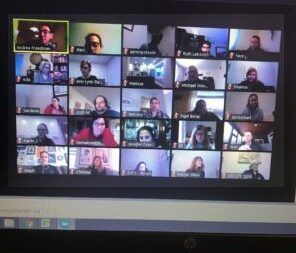This blog post is not intended to indicate any inside information about impending school closures! I know no more than anyone else about how long we will be blessed with in-person learning at OJCS. Despite all the challenges – the daily stressors on families when symptoms and exposures occur, the life juggling required to accomodate unplanned learning from home and the extraordinary responsibility our teachers have assumed with grace and care to provide seamless hyflex learning – we are doing remarkably well! I can’t visit classrooms like I used to, but from what I can see with my own eyes or on a screen, we are delivering on our promise.
Part of what happens at the beginning of each year at OJCS, is that I meet with each teacher to develop an individualized Professional Growth Plan (PGP) for the year. We believe deeply in lifelong learning and our teachers all establish growth goals to help them be the best teachers they can be. Through those conversations, we have come to believe that one thing we can be doing now – ahead of any pivot to distance learning should it come – is to role-play distance learning here in school. We didn’t have any time last year to experience distance learning from the back-end (what does it look like from the student’s perspective?) or to do specific skill-building or troubleshooting, especially at the youngest grades. We are encouraging all our teachers to take the time now, while we have it, to dedicate a period, a block, a half-day or even a full day to role-play “Distance Learning in Grade X”. Let’s have the teacher teach from his or her device while students learn from theirs. Let’s have the teacher create asynchronous lessons that students should (even in K) be able to navigate without (or with limited) parent support and see what happens.
What does this mean for me now?
Great question! Not much. You may wish to pay attention to how and when your child(ren)’s teacher(s) schedule these simulated days. If your child is in Grades K-3, you may see a request from teachers that those students who do have access to devices (tablets or laptops) begin to bring them to school (if you are comfortable). Whereas we are BYODevice in Grades 4-8, we rely on the school’s iPads in Grades K-3. Although we are looking to add to our current supply, if you have a device that your child in Grades K-3 would likely be using in the case of a pivot, you may wish to send it for these scheduled practices.
Besides access to devices, how else are teachers preparing for the pivot?
We are seeing a direct result of the learning teachers did during our Pre-Planning Week and an increase in successful asynchronous and hyflex learning. Please revisit this post to see why and how your child(ren)’s teacher(s) are beginning to embrace platforms like Classkick and Nearpod.
How else can we – as parents – prepare for the pivot?
Another excellent question! Here, I would advise you to revisit this post from last spring that clarified home expectations. Our goal is NOT to provide materials for homeschooling! Our goal is to allow high-quality, rigourous, OJCS learning to happen at home.
We don’t know if and when this is coming, but we do know that we want to be as prepared as we can. If we do these things now when we have ample opportunity to correct, adjust and adapt, it will make any kind of pivot that much more seamless and successful.

If you were playing the COVID “pivot” drinking game, please find a comfortable place to rest for the rest of the day!

This is normally the time of year where I post an update of our school’s philosophy with regard to standardized testing as we prepare to take this year’s exam. This was the year that we were scheduled to pilot the CAT-5 (we have been taking the CAT-4) and to again expand the grades who take it. The eventual goal is for each grade to take this exam each year so that we have the most actionable data. This year, however, the CAT-5 will not roll out due to COVID and most private schools have decided to pause standardized testing. We, too, shall pause although I would have loved to see the data. Our theory of the case is that we did not see too much slippage last spring because of our response. I would love to see if the data bore that out, but even figuring out the logistics of proctoring these exams in compliance with safety protocols is not a good use of our resources. We look forward to resuming standardized testing in 2020-2021.


